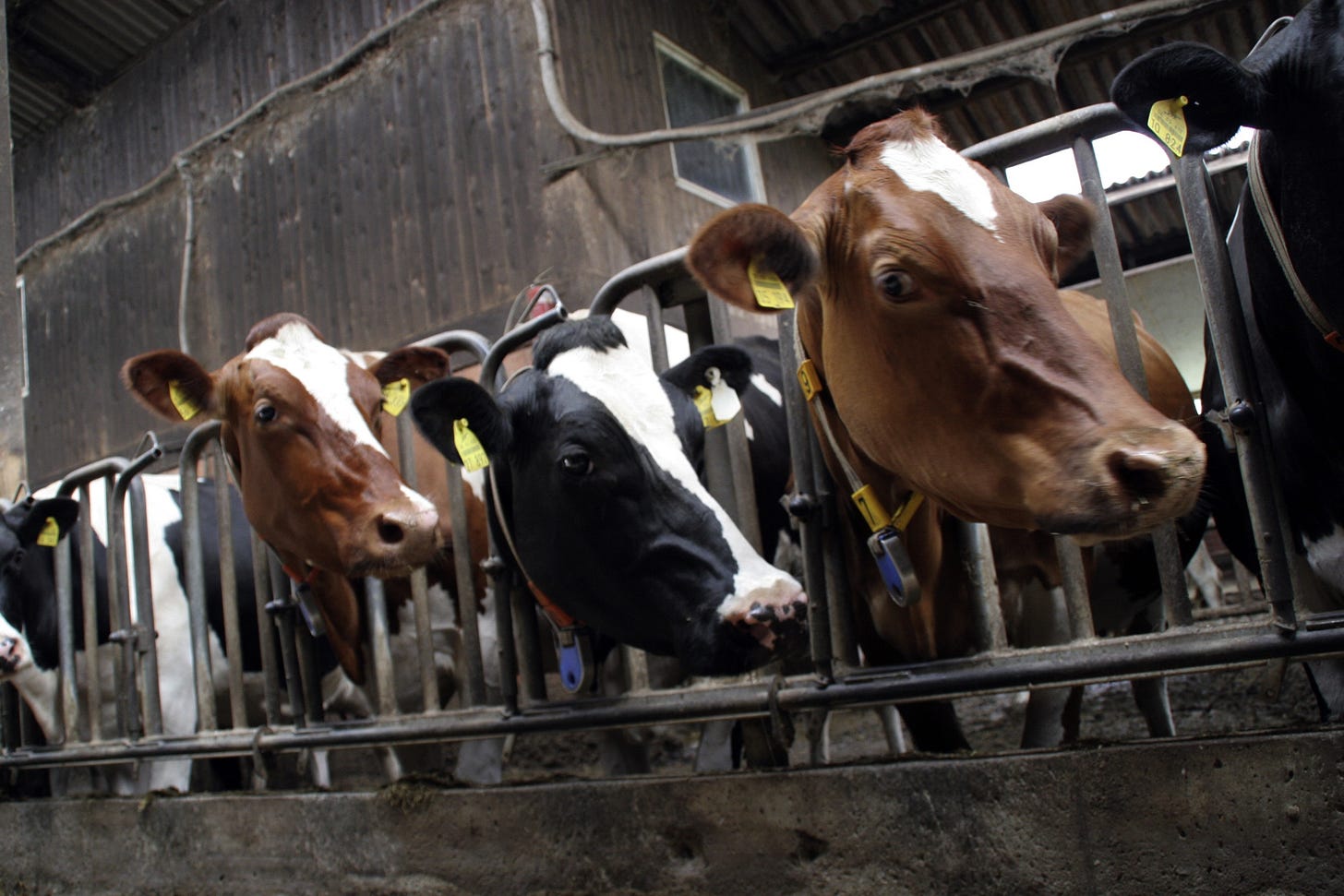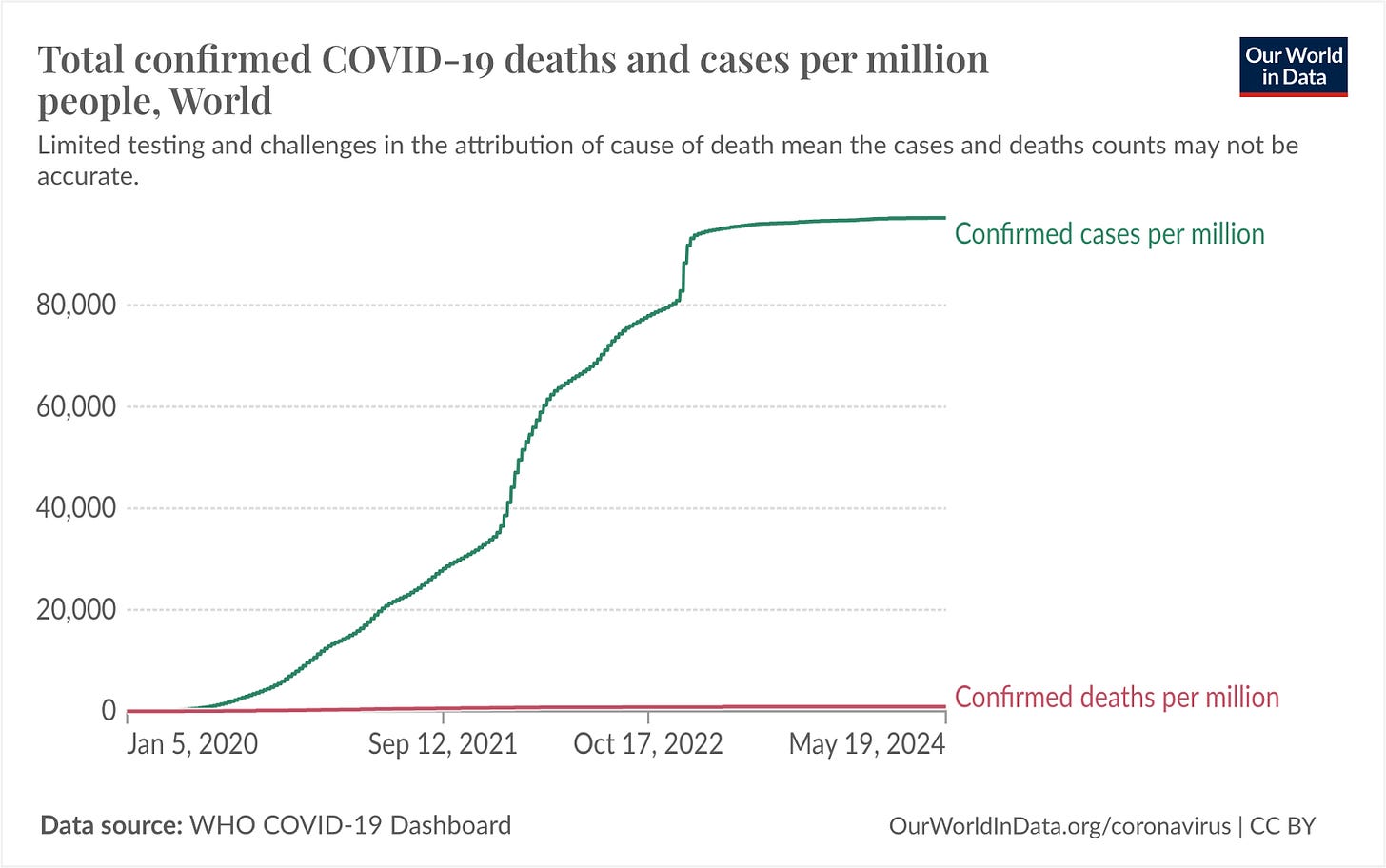You’ve seen it in the news: Bird flu has recently jumped to cows and there is growing concern it could become the next global pandemic. Traces of the flu have already been detected in 1 in 5 grocery store milk samples.
Important to know: this is not a natural disaster but largely a man-made crisis.
This article will explain how we can avoid another catastrophe like COVID-19, or one that may be significantly worse.
Our options are limited. But fortunately, there is one simple thing we all can do!
The next pandemic could be much worse than COVID
The COVID pandemic has killed over 7 million people and led to an alarming rise in loneliness, social inequality, mental health problems, domestic violence, suicidal ideation, and drug overdose deaths. Global poverty increased for the first time in a generation.
Yet, all of this was nothing compared to what awaits us if we don’t start behaving more wisely. World health leaders have warned that a new pandemic could be 20 times or even 100 times worse than COVID.
COVID was only a category two or three in the ‘hurricane scale’ of pandemics. Experts are afraid a next pandemic could have a much higher fatality rate, killing every second person infected.
Coincidentally, this is exactly the fatality rate that bird flu already has:
Bird flu is extremely deadly in humans
The bird flu strain currently in the news — A/H5N1 — has killed half of the people diagnosed with it over the last 20 years. The World Health Organization considers this bird flu to be exceptionally deadly in humans and a major pandemic threat.
“The mortality rate is extraordinarily high because humans have no natural immunity to the virus”
— Jeremy Farrar, chief scientist of the WHO
Comparison with COVID-19
As you will see from the diagram below, only a tiny fraction of the people infected with COVID died.
Now imagine what this diagram would look like for a disease where every second infected person dies.
COVID already pushed us to our limits. We had major problems with absenteeism of healthcare workers due to exhaustion, burnout and increased risk of infection.
Now imagine a pandemic where a much larger portion of healthcare workers not only fall ill but also die — and where many of those remaining, understandably, are too scared to come to work. This is not an absurd fantasy. This is a very real possibility. And it could catapult us into an utterly dystopian nightmare much quicker than we think.
Bird flu could soon spread between humans
While there is no indication that virus A/H5N1 is already spreading between humans, this could happen anytime. Prof. Derek Smith, Director of the Centre for Pathogen Evolution at the University of Cambridge, describes this constant threat as a “huge concern”.
“The worry is that the virus never stands still but is always mutating. This is the monster lurking in the undergrowth, the one that makes epidemiologists shudder.”
—Michael Greger, M.D.
Horrific symptoms are possible
Suffering an agonizing death is only one of many possible gruesome consequences of a next pandemic. Infectious diseases can also cause blindness, lumps on your face, deformities and loss of body parts, paralysis, tree-bark-like warts, painful rash, leaking lesions, and vomiting blood — just to name a few examples. After drinking milk from A/H5N1-infected cows, cats have already suffered brain infections and blindness before they eventually died.
All eyes on zoonotic diseases
Diseases which are transmitted from animals to humans are called “zoonotic diseases”. They have been responsible for some of the most devastating pandemics in history, including the Spanish flu pandemic, the Black Death pandemic, the COVID-19 pandemic, and many more.
The majority (up to 75%) of all new and emerging infectious diseases are zoonotic. Every year, zoonotic diseases cause 2.5 billion cases of human illness and millions of deaths worldwide.
“Scientists always knew a deadly virus was going to jump from animals to humans: COVID was not the first time it has happened, and it won’t be the last.”
— Jacqueline Garget, Communications Manager at University of Cambridge
While details are still being debated, studies agree that the Covid-19 pandemic most likely started with animals being sold at a Chinese seafood market.
The livestock sector: a key driver of pandemic risk
Big dairy and meat producers in Western countries have a strong lobby and engage in significant disinformation efforts to cover up their horrific impacts on animals, environment, climate, and human well-being — but they are just as dangerous and despicable as Chinese wet markets, if not worse.
“The production, distribution and consumption of animal-based products (such as meat, dairy and eggs) is a major risk for zoonotic transmission.”
— Harman S. Sandhu et al. 2021
There are good reasons why the livestock sector has been described by experts as a “infectious disease trap”, “a ticking time bomb for future viruses”, “a ticking pathogen bomb”, and “a hidden pandemic time bomb”.

Scientists have long warned that farmed animals can act as “reservoirs for zoonotic pathogen spillover”. A recent EU report concluded that livestock farming has been implicated in the emergence of a large proportion of zoonotic diseases.
And this is where human greed comes in: Despite ceaseless warnings about the manifold dangers of animal agriculture, global consumption of animal products has risen steeply over the last years. The global production of animal flesh for human consumption was 45% higher in 2020 than in 2000.
Why is the livestock sector a source of infectious diseases?
Livestock has 30 times more biomass than all wild land mammals in the world, combined. The vast majority of these farmed animals are kept under conditions that promote the emergence and mutation of infectious diseases.
Crowded into tight spaces, they are subjected to high stress levels, insufficient sunlight, open wounds, and poor ventilation. These environments are not just inhumane; they are ideal breeding grounds for the next pandemic. 99 percent of farmed animals in the U.S. are factory farmed, but similar conditions can also be found on many certified organic farms.
“The more animals jammed together, the more spins the virus may get at the roulette wheel while gambling for the pandemic jackpot.”
— Michael Greger, M.D.
Farmed animals act as intermediary hosts for emerging zoonotic diesases, facilitating their transmission from wild animals to humans. A new study concluded that the next pandemic could start in the U.S. through industrial animal agriculture, fur farming, and the use of animals for entertainment.
Livestock farming is also the leading cause of deforestation worldwide, which impacts pandemic risk because it displaces wildlife species, putting them in closer proximity with each other and to humans.
Phasing out livestock farming is necessary to contain pandemic risk
Relying on animal exploitation for food production is unsustainable and dangerous. The bird flu outbreak is a stark reminder of the consequences of ignoring this reality.
To eliminate the virus risks posed by the livestock sector, we must transition to a safer and more sustainable plant-based food system.
This is our only meaningful option. Recent research found that we have no comprehensive strategy to mitigate zoonotic disease risk. Even if a bird flu pandemic is momentarily averted, the conditions in the livestock industry will remain a breeding ground for viruses to constantly mutate and multiply.
In general, studies show that a large-scale shift to a vegan lifestyle could radically improve public health, saving 8 million lives and up to $1 trillion in healthcare costs every year.
We ALL need to get active
If we don’t change our consumption habits, companies won’t change. If we don’t build public pressure, politics won’t change. Without us getting active, those “up there” will neither be willing nor able to save us.
Switching to a plant-based lifestyle, and inspiring others to do the same, is the single best way you can help reduce the risk of a next catastrophic pandemic.
Ready to lift the next veil
Beyond pandemic prevention, ditching animal products is also crucial in fighting animal cruelty, rainforest destruction, climate change, biodiversity loss, water and air pollution, antibiotic resistance, and world hunger. I’m here to raise awareness. But I need YOUR help!
I have just started my vegan blogging journey. With your support, I will be able to pour all my passion and energy into this project.
A million thanks to those who become supporting subscribers! You help me keep Vegan Horizon paywall-free and available to everyone.





You are the most important Substacker I follow by far. Thank you for all your hard work and great pieces.